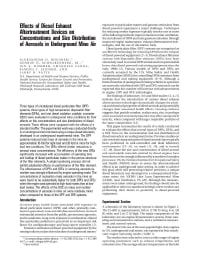Mining Publication: Effects of Diesel Exhaust Aftertreatment Devices on Concentrations and Size Distribution of Aerosols in Underground Mine Air
Original creation date: September 2009
Authors: AD Bugarski, GH Schnakenberg, JA Hummer, E Cauda, SJ Janisko, LD Patts
NIOSHTIC2 Number: 20035878
Environ Sci Technol 2009 Sep; 43(17):6737-6743
Three types of uncatalyzed diesel particulate filter (DPF) systems, three types of high-temperature disposable filter elements (DFEs), and one diesel oxidation catalytic converter (DOC) were evaluated in underground mine conditions for their effects on the concentrations and size distributions of diesel aerosols. Those effects were compared with the effects of a standard muffler. The experimental work was conducted directly in an underground environment using a unique diesel laboratory developed in an underground experimental mine. The DPF systems reduced total mass of aerosols in the mine air approximately 10-fold for light-load and 20-fold or more for high-load test conditions. The DFEs offered similar reductions in aerosol mass concentrations. The efficiency of the new DFEs significantly increased with accumulation of operating time and buildup of diesel particulate matter in the porous structure of the filter elements. A single laundering process did not exhibit substantial effects on performance of the filter element The effectiveness of DPFs and DFEs in removing aerosols by number was strongly influenced by engine operating mode. The concentrations of nucleation mode aerosols in the mine air were found to be substantially higher for both DPFs and DFEs when the engine was operated at high-load modes than at low-load modes. The effects of the DOC on mass and number concentrations of aerosols in mine air were relatively minor when compared to those of the DPF and DFE systems.

NIOSHTIC2 Number: 20035878
Environ Sci Technol 2009 Sep; 43(17):6737-6743
- A Computer Software Program that Estimates Air Quantity Requirements in Large Opening Stone Mines
- Control Technologies and Strategies for Reducing Exposure of Underground Miners to Diesel Emissions
- DEEP Project on Evaluation of Diesel Particulate Filters at Inco's Stobie Mine
- Diesel Aerosols and Gases in Underground Mines: Guide to Exposure Assessment and Control
- Effects of Sintered Metal Diesel Particulate Filter System on Diesel Aerosols and Nitric Oxides in Mine Air
- Evaluation of the SKC� DPM Cassette for Monitoring Diesel Particulate Matter in Coal Mines
- Mutagenicity of Diesel Exhaust Particles from an Engine with Differing Exhaust After Treatments
- Near Real Time Monitoring of Diesel Particulate Matter in Underground Mines
- Real-Time Estimation of Elemental Carbon Emitted from a Diesel Engine
- Technology News 514 - The Air Quantity Estimator (AQE): A New Computer Software Tool for Large-opening Mine Ventilation Planning